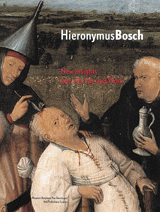
Vandenbroeck 2001c
“High Stakes in Brussels, 1567. The Garden of Earthly Delights as the Crux of the Conflict Between William the Silent and the Duke of Alva” (Paul Vandenbroeck) 2001
[in: Jos Koldeweij, Bernard Vermet and Barbera van Kooij (eds.), Hieronymus Bosch. New Insights Into His Life and Work. Museum Boijmans Van Beuningen-NAi Publishers-Ludion, Rotterdam, 2001, pp. 86-90]
Vandenbroeck begins this contribution with a tribute to professor J.K. Steppe who amassed an enormous amount of information about Bosch in the course of his life but published little. As a result of this Steppe never received the international recognition that he deserved. One of the things Steppe brought to light was that in 1568 Fernando Alvarez de Toledo, the Duke of Alva, confiscated the Brussels possessions of William of Orange (also known as William the Silent): among these possessions was the original Garden of Delights. By studying Steppe’s documentation about this, Vandenbroeck has come to a remarkable observation: on 20th January 1568 (new style) Alva had already an inventory of the Brussels Court of Nassau drawn up, although only on 24th January William was summoned to plead his defence for his ‘crimes’, on the 11th March at the latest, and only on 28th May William’s banishment and judgment were pronounced. At the surface this conflict between Alva and William of Orange was a religious-political one, but apparently it was triggered by Bosch’s Garden of Delights. In the fall of 1567 Alva tracked down the triptych because he wanted to commission a copy of the Garden of Delights tapestry, then owned by cardinal Granvelle. To get rid of Alva a close assistant of Granvelle told the Duke that the original painting of the Garden of Delights was in Brussels, at the Court of Nassau.
The inventory of 20th January 1568 mentions ‘ung grand tableau devant la cheminee de Jeronimus Bosch’, very likely the Garden of Delights. In May 1568 the triptych was apparently hidden somewhere in the palace, for Vandenbroeck quotes a contemporary document which tells us that Pieter Col, the palace’s concierge, was tortured in a very cruel way in various prisons during 18 months, i.a. because he ‘oult du commenchement faict refuz de bailler une painture de Jeronimus Bosseman’ [had refused from the start to deliver a painting by Jheronimus Bosch].
Vandenbroeck traces back Alva’s hatred for William of Orange to the fact that originally Alva was going to marry Mencia de Mendoza, the Marquess of Cenete (Alva and Mencia were both born in 1508). To prevent both families from gaining too much power, Charles V decided that Mencia had to marry Henry III of Nassau, who possessed the Garden of Delights. Henry III’s son, René de Châlon, was William the Silent’s uncle, and in this way William inherited the Garden of Delights. By confiscating the triptych in 1568 Alva was able to take revenge for the humiliation he had undergone in the past.
This contrubition is highly interesting for the Bosch research, especially for the history of the Garden of Delights triptych.
[explicit]